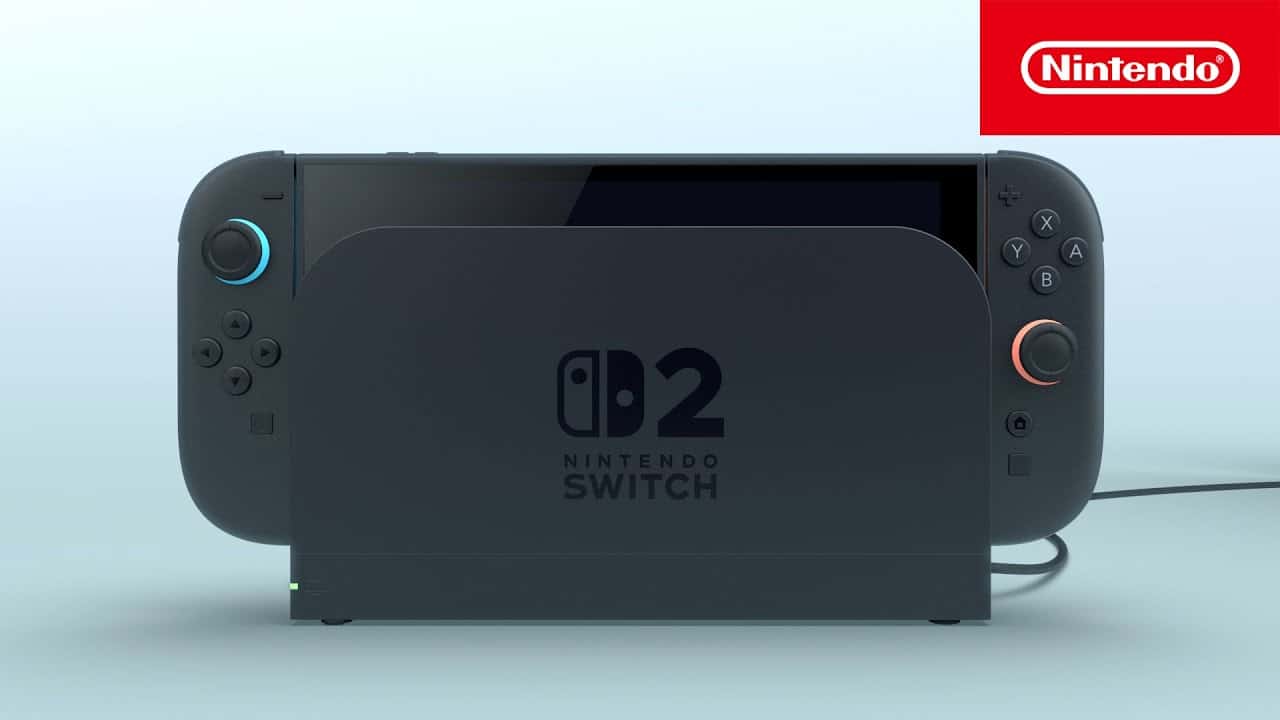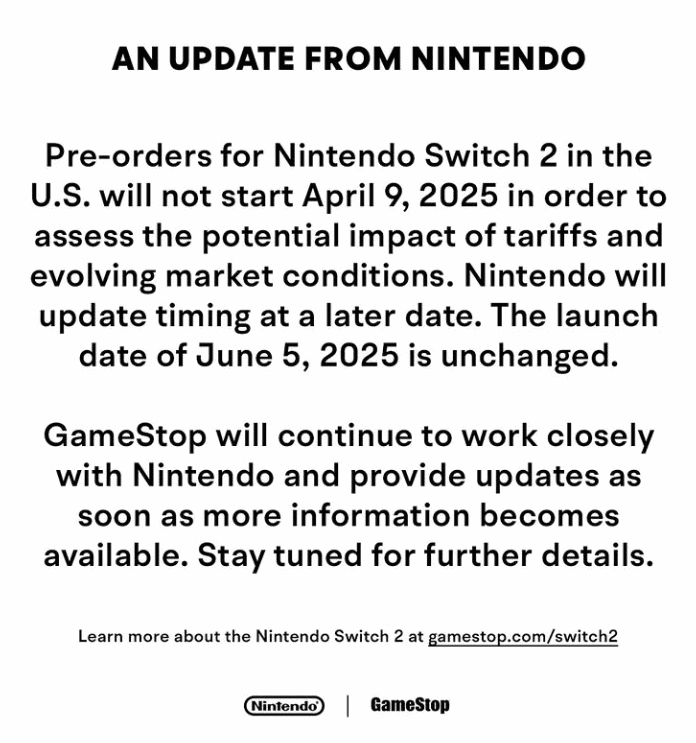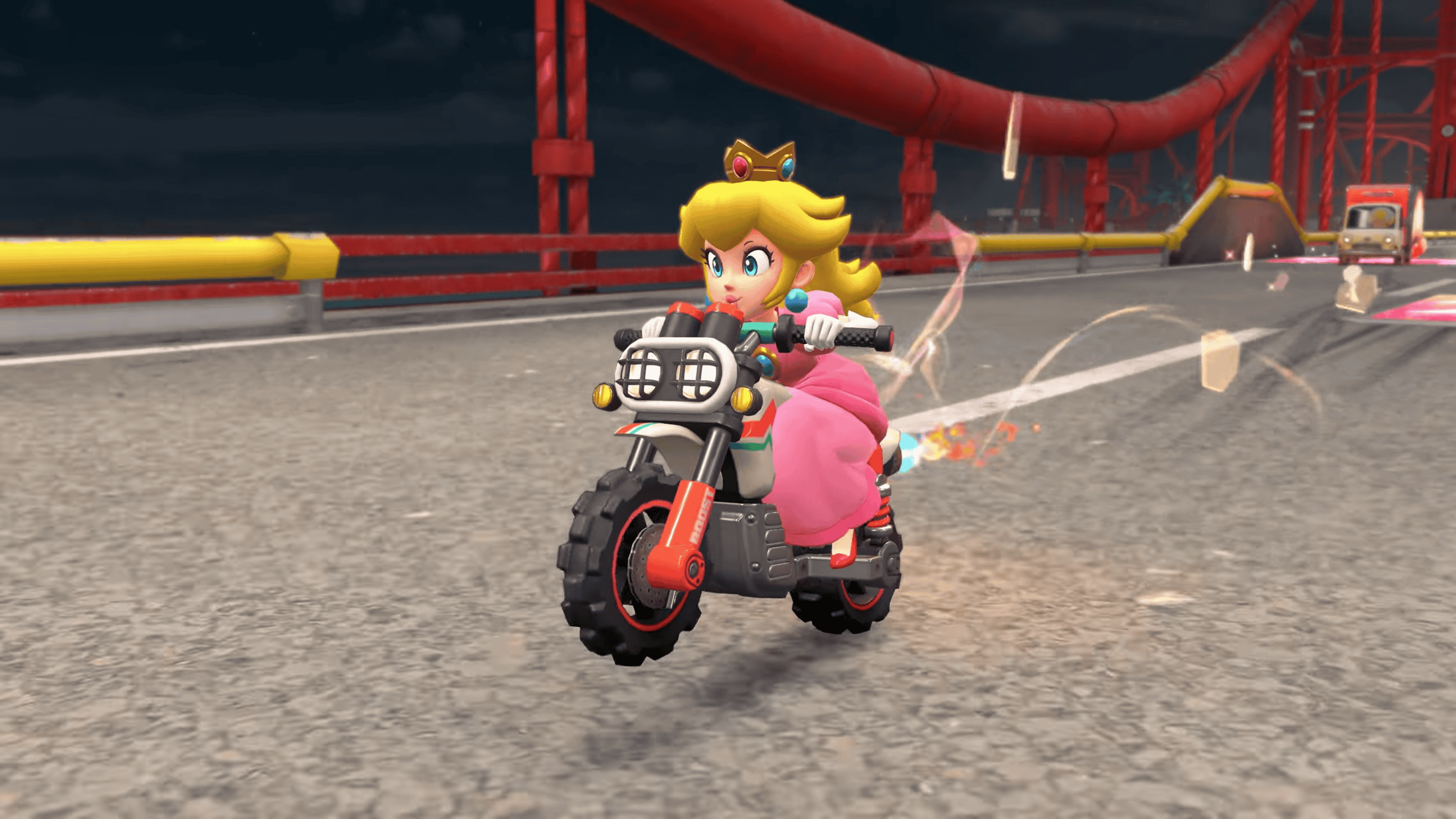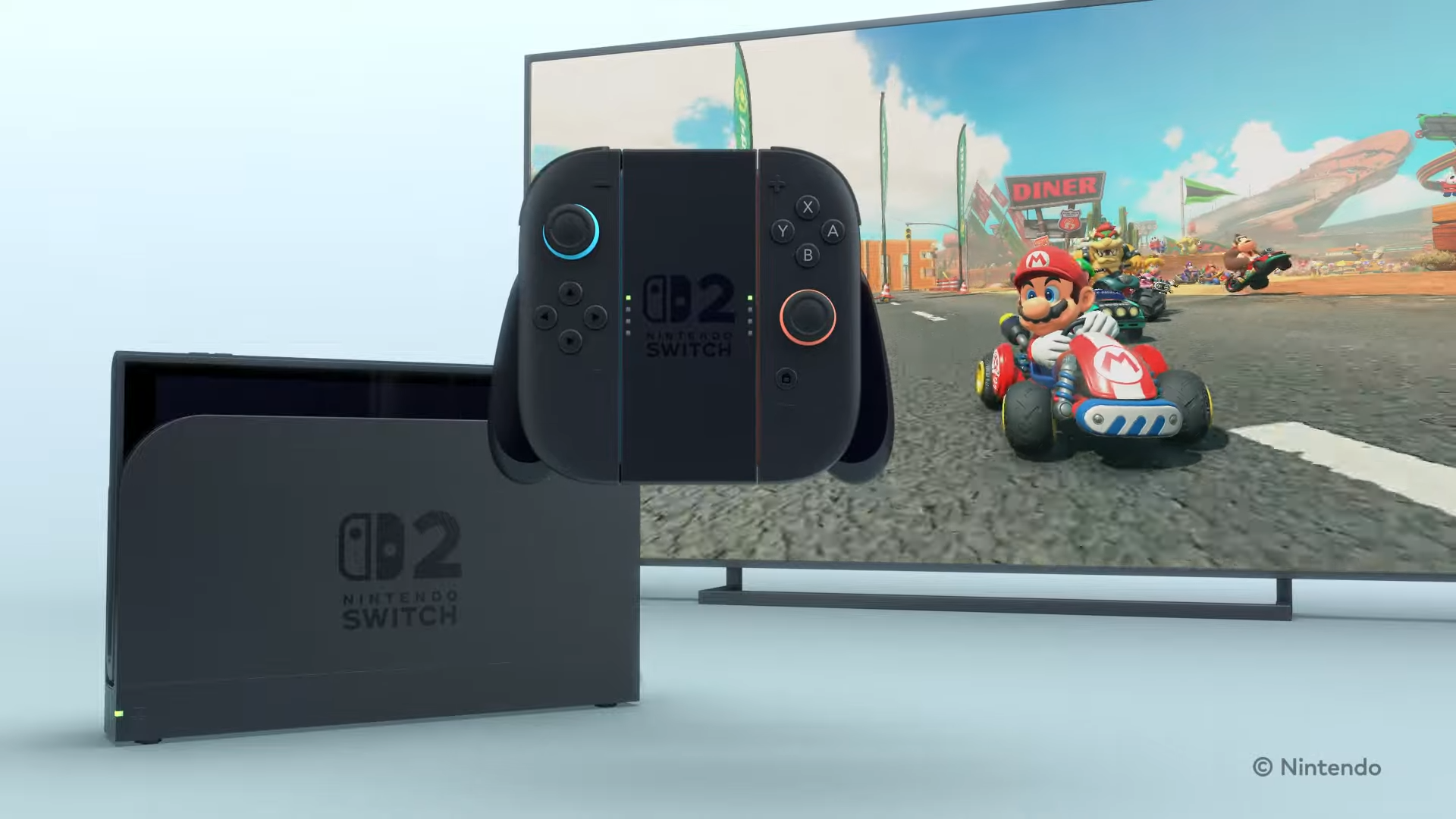Nintendo has canceled the original Switch 2 pre-order date in the United States and has not provided any guidance yet on when pre-orders will open up (if ever). Originally scheduled to begin taking pre-orders on April 9, 2025, the company has indefinitely postponed this to assess the potential impacts of tariffs and changing market conditions. Despite the pre-order delay, Nintendo has confirmed that the actual launch date of June 5, 2025 remains unchanged.
Originally, as part of the Switch 2 announcement, we were expecting the costs of the console to be $449.99 MSRP and the Nintendo Switch 2 + Mario Kart World Bundle to be $499.99 MSRP. However, now that Japan (and other countries) are facing steep tariffs its expected that these costs will go up. The listed tariffs for Japan are 24%, but it’s hard to assess the full tariffs the device will be given that different components will be manufactured in different parts of the world.

The Japanese gaming giant cited uncertainty surrounding U.S. tariffs as the primary reason for this decision. This move comes as Nintendo carefully evaluates how potential trade policies might affect pricing and availability in the American market. The company wants to ensure they have a clear understanding of these economic factors before opening pre-orders to consumers.

This cautious approach highlights the complex relationship between international trade policies and the gaming industry. While fans may be disappointed by the delay in pre-order availability, Nintendo’s decision suggests the company is prioritizing transparency and strategic planning in response to evolving economic conditions.
Understanding the Impact of Tariffs on Nintendo Switch 2 Pre-Orders
Nintendo’s decision to delay pre-orders for the Switch 2 in the United States stems from recent tariff announcements by President Donald Trump. These tariffs impose a 10% baseline on all imports, with significantly higher rates targeting specific countries: 34% on Chinese goods and 46% on imports from Vietnam. Given that Nintendo has previously shifted production to Vietnam to mitigate earlier tariffs on China, the new tariffs present a complex challenge for the company.
Potential Price Adjustments and Consumer Impact

The newly imposed tariffs could lead to increased costs for manufacturing and importing the Switch 2, potentially prompting Nintendo to adjust the console’s retail price to maintain profit margins. The Switch 2 is already priced at $449.99, a notable increase from its predecessor’s launch price of $299. Any further price hikes could affect consumer demand and sales projections.
Strategic Supply Chain Considerations
Nintendo has a history of adapting its supply chain strategies in response to international trade policies. The company previously relocated some production from China to Vietnam to avoid earlier tariffs. With both countries now facing substantial tariffs, Nintendo may need to explore alternative manufacturing locations or renegotiate supplier agreements to manage costs effectively.
Broader Industry and Economic Implications
Nintendo’s postponement of pre-orders highlights the immediate impact of trade policies on the tech and gaming industries. The tariffs have contributed to significant market volatility, with major indices experiencing sharp declines. Companies across various sectors are reassessing their operations and pricing strategies in light of these economic shifts.
Looking Ahead: Nintendo’s Next Steps
While the pre-order delay introduces uncertainty for consumers eagerly awaiting the Switch 2, Nintendo remains committed to its original launch date of June 5, 2025. The company plans to provide updates on pre-order availability as it continues to evaluate the situation. Consumers are advised to stay informed through official Nintendo communications and reputable news sources for the latest developments.
In summary, Nintendo’s proactive approach in delaying pre-orders reflects its intent to navigate the complexities introduced by recent tariff implementations carefully. This strategy aims to ensure that the company can deliver its new console to the U.S. market effectively, balancing both business considerations and consumer expectations.
Key Takeaways
- Nintendo has delayed Switch 2 pre-orders in the U.S. beyond April 9 due to tariff concerns, but the June 5 launch date remains in place.
- The company is taking time to assess how potential trade policies might impact pricing and market conditions before accepting pre-orders.
- This decision demonstrates Nintendo’s strategic approach to navigating economic uncertainties while maintaining their product launch timeline.
Impact of Tariff Uncertainty on Nintendo Switch 2 Launch
Nintendo’s decision to delay the Switch 2 pre-orders stems directly from economic concerns that could affect pricing and availability. The company must navigate potential tariffs that would impact both their manufacturing costs and consumer price points.
Understanding the Tariffs and Their Implications
Nintendo announced that pre-orders for the Switch 2 will not begin on April 9, 2025 as originally planned. This delay is specifically tied to tariff uncertainty in the United States market.
The company needs time to assess how potential new import taxes might affect the console’s retail price. If significant tariffs are implemented, Nintendo faces difficult choices about absorbing costs or passing them to consumers.
Gaming hardware typically operates on thin profit margins already. A 10-25% tariff could force Nintendo to either raise the Switch 2’s price or accept reduced profits on each unit sold.
These economic calculations are especially important for Nintendo as they plan their first major console launch in over eight years.
Historical Impact on the Gaming Industry
Previous tariff situations have created challenges for the gaming industry. In 2019, when tariffs on Chinese goods were threatened, many manufacturers scrambled to relocate production or adjust pricing strategies.
Sony and Microsoft both faced similar issues when launching the PS5 and Xbox Series X during periods of trade uncertainty. Both companies ultimately absorbed some costs rather than significantly raising prices.
Nintendo’s previous consoles have been manufactured primarily in China and other Asian countries. This makes them particularly vulnerable to U.S.-China trade tensions.
The delay in Switch 2 pre-orders demonstrates how global trade policies can directly impact entertainment technology launches. Gaming companies must now build tariff contingencies into their launch plans.
Nintendo likely hopes this delay will provide clarity about the trade environment before committing to final pricing and distribution plans.
The Nintendo Switch 2: Anticipated Features and Upgrades
The Nintendo Switch 2 represents a significant leap forward from its predecessor with substantial hardware improvements and enhanced gaming capabilities. The upcoming console aims to deliver a more immersive gaming experience while maintaining the versatility that made the original Switch so popular.
Comparing Nintendo Switch and Nintendo Switch 2 Specifications
The Nintendo Switch 2 is expected to feature a significant boost in processing power compared to the original model. Early reports indicate an NVIDIA custom chipset that supports advanced graphics technologies, including DLSS (Deep Learning Super Sampling) for sharper images.
The new console will likely offer:
- Display: 8-inch OLED screen (up from 6.2-inch LCD)
- Resolution: 1080p handheld mode, 4K output when docked
- Storage: 256GB internal (increased from 32GB)
- Battery life: Approximately 7-9 hours (improved from 4.5-9 hours)
- RAM: 8GB (doubled from 4GB)
These hardware upgrades should allow for more detailed game worlds and smoother performance in both handheld and docked play modes.
Expected Improvements in User Experience
Nintendo is focusing on enhancing the overall user experience with the Switch 2. The console is rumored to feature improved Joy-Con controllers with better drift resistance and more precise haptic feedback.
The eShop interface will likely receive a complete overhaul, making game discovery and purchases more intuitive. Backward compatibility with original Switch games appears to be confirmed, protecting players’ existing libraries.
Online features may see substantial improvements too. Expanded cloud saving, more reliable online multiplayer, and potential integration with Nintendo’s mobile apps could create a more connected ecosystem.
Despite the higher price point of $449.99, these quality-of-life improvements may justify the investment for many Nintendo fans eager for a more powerful portable gaming experience.
Pricing Strategy for the Nintendo Switch 2 Amidst Economic Challenges
Nintendo faces tough decisions regarding the Nintendo Switch 2’s pricing strategy in the United States. According to recent reports, the new console is expected to retail for $450, which is 50% higher than the original Switch’s launch price.
This significant price increase appears to be influenced by several economic factors, including potential tariffs on exports to the U.S.
The Trump administration’s proposed tariffs could have a substantial impact on gaming hardware prices. Some industry analysts suggest these tariffs might increase console prices by as much as $200.
Nintendo has delayed pre-orders in the U.S. specifically due to these tariff concerns, though the planned June 5 launch date remains unchanged. The company is currently reviewing its pricing and strategy for the American market.
Consumers have expressed mixed reactions to the $450 price point. This higher price extends to games as well, with titles like Mario Kart World reportedly priced at $80.
Factors Influencing Switch 2 Pricing:
- Potential tariff implementation
- Manufacturing costs
- Market competition
- Economic uncertainty
Nintendo must balance profitability against consumer expectations in this challenging economic environment. The company’s final pricing decisions will likely reflect both market realities and its long-term strategy for the Switch 2’s success.
Revised Release Date and the Effect on Consumer Anticipation
Nintendo has pushed back the pre-order date for the Switch 2 in the United States due to uncertainty surrounding new tariffs. While the global release date remains set for June 5, 2025, American consumers face a waiting game.
The delay comes after the Trump administration implemented new tariff policies affecting electronic imports from China. These tariffs could potentially increase the Switch 2’s retail price by a significant amount.
Originally priced at $449.99, industry analysts worry the final US price tag might be substantially higher if Nintendo passes these additional costs to consumers.
The postponement has created mixed reactions among Nintendo fans. Some express frustration about the uncertainty, while others appreciate Nintendo’s transparency about the situation.
Social media has been buzzing with speculation about the final US release timeline. Gaming forums are filled with debates about whether the delay signals a possible price increase above the announced $449.99 mark.
Despite these concerns, market analysts remain optimistic about the console’s sales prospects. As one report notes, “we do not expect the price point to impact early adoption” of the Switch 2.
Nintendo has promised to announce a revised pre-order date for US customers once there is more clarity about the tariff situation. The company aims to maintain its competitive pricing strategy despite these unexpected challenges.
Frequently Asked Questions
Nintendo’s sudden pre-order delay for the Switch 2 in the United States has created significant uncertainty among consumers and retailers alike. The following questions address the most pressing concerns related to this tariff-induced schedule change.
What new date has Nintendo set for the Switch 2 pre-order in the United States?
Nintendo has not yet announced a new date for Switch 2 pre-orders in the United States. The company postponed the originally planned April 9, 2025 pre-order launch indefinitely.
Nintendo stated they need time to “assess the potential impact of tariffs and evolving market conditions” before committing to a new pre-order date. Industry analysts expect Nintendo to announce updated timing once they’ve completed their tariff impact assessment.
How will the delay in the Switch 2 pre-order affect customers who have already placed orders?
No customers have been able to place actual pre-orders for the Nintendo Switch 2 in the United States yet. The delay occurred before the pre-order window officially opened.
Any waiting lists or interest registrations that retailers might have collected remain valid, but do not constitute actual pre-orders. Consumers who registered interest with retailers will likely be notified when official pre-orders become available.
What are the specific tariff concerns impacting the Nintendo Switch 2 pre-order schedule?
The primary concern stems from the Trump administration’s proposed new tariffs on exports to the United States. These tariffs could significantly increase Nintendo Switch 2 pricing.
According to industry experts, these tariffs might add approximately $200 to the retail price of gaming consoles like the Switch 2. Nintendo likely postponed pre-orders to determine final pricing after assessing how these tariffs would affect their manufacturing and distribution costs.
Will the Nintendo Switch 2 pre-order delay impact the official release date of the console?
Based on available information, the Switch 2’s planned release date of June 5, 2025, remains unchanged despite the pre-order delay. Nintendo has only postponed the pre-order phase at this time.
However, analysts note that prolonged uncertainty about tariffs could potentially force Nintendo to reconsider the release timeline if pricing and supply chain issues aren’t resolved quickly. The company has not indicated any plans to delay the actual launch.
What steps is Nintendo taking to address the tariff-related uncertainties?
Nintendo is currently conducting a comprehensive assessment of how the proposed tariffs would impact their production costs and retail pricing strategy. This evaluation is the primary reason for the pre-order delay.
The company may be exploring several options, including potential manufacturing relocations, absorbing some cost increases, or adjusting retail pricing. Nintendo might also be engaging with industry associations to advocate for gaming hardware exemptions from certain tariff categories.







